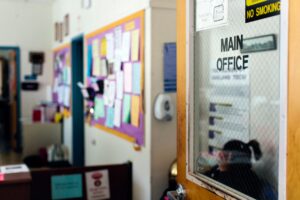
Black teachers: How to recruit them and make them stay

Lessons in higher education: What California can learn

Keeping California public university options open

Superintendents: Well-paid and walking away

The debt to degree connection

College in prison: How earning a degree can lead to a new life

Mathematics plays a central role in winnowing opportunities for students to enter and succeed in college. In California, students can graduate from high school with just two years of math, including a single college-preparatory course, Algebra 1. But if they don’t also complete Geometry and Algebra 2 (or, with the introduction of the Common Core state standards, an integrated pattern of courses covering the same material), students aren’t eligible to attend either of the state’s public university systems.
Last month, Governor Jerry Brown took an important step toward insuring more students the chance to take those courses: He signed a bill, SB-359, requiring school districts to adopt “fair, objective, and transparent” policies for determining how to place students into math courses when they start high school. The new policy means that students can’t arbitrarily be directed off the college math-ready track. This is good news for ensuring that more students, including more underrepresented minorities, acquire the foundational math skills they need before college.
But bad news awaits too many students at the college gateway. That’s because taking the right courses in high school doesn’t guarantee access to college-level math courses at the state’s colleges and universities. To varying degrees, all three higher education systems in California use placement tests to determine whether students are ready for required college-level math courses. Those who aren’t – including up to 85 percent of community college students and 33 percent of students at California State University – must take one or more remedial courses.
The problem is that the placement tests used by most campuses have limited efficacy for placing students. Research in California and nationally demonstrates that, using traditional placement tests, up to a quarter of community college students are under-placed, required to take remedial math courses even though they could have succeeded in a college-level course. While the tests were originally intended to ensure students were prepared for college-level courses, new evidence demonstrates that remedial math courses don’t improve students’ outcomes in college, and may even worsen them. The majority of community college students assigned to remedial math courses never make it to college-level courses, not because they fail, but because they exit the remedial sequence.
In writing my recent report, “Degrees of Freedom: Probing Placement Policies at California Colleges and Universities,” I interviewed several students who felt that remedial math placements deterred their progress in college. A student at Berkeley City College told me she had passed Pre-Calculus in her senior year of high school, but a math test score required her to repeat three courses: Pre-Algebra, Elementary Algebra and Intermediate Algebra. Another, at City College of San Francisco, was assigned to take four remedial courses, starting with Arithmetic, even though she had taken Trigonometry in high school.
Each year, tens of thousands of students like them may be prevented from taking required math courses that they could likely pass. They are tripped up by placement tests, even though research repeatedly shows that high school records are more accurate predictors of students’ college performance.
The problem may be that standardized tests in general disadvantage some students. A recent study on the SAT indicates that race and ethnicity are the single largest determinant of California students’ scores on that test. It also found that false negatives (test scores that underrate a student’s actual abilities) were most likely to affect underrepresented minority students. It is easy to imagine that a similar pattern prevails for commonly used college placement tests, since those tests were developed by the same companies that produce the SAT and ACT. That concern is exacerbated by the knowledge that black and Latino community college students are more likely to underestimate their own math abilities, as described in a paper by researchers at USC. That tendency decreases the chances that students will challenge a low placement.
Earlier this year, ACT admitted the limited predictive validity of its Compass placement test, and decided to discard it. Recently, CSU system officials acknowledged that a 2010 study by ETS doesn’t satisfy questions about the validity of the system’s math placement test. They have called for a new analysis that may help ensure that students aren’t sent to remedial math courses unnecessarily.
Fortunately, the state’s higher education systems have begun to develop ways to mitigate the problem of inaccurate placement, even in the absence of legislation:
These efforts represent good initial steps. But they need to be refined and expanded to ensure that math placement policies don’t derail students’ chances to succeed once they go to college. Math placement policies deserve far more scrutiny, given their outsized impact on students’ college and career trajectories.
•••
Pamela Burdman is a Berkeley-based higher education policy analyst and a former program officer at the William and Flora Hewlett Foundation.
The opinions expressed in this commentary represent those of the author. EdSource welcomes commentaries representing diverse points of view. If you would like to submit a commentary, please review our guidelines and contact us.

Panelists discussed dual admission as a solution for easing the longstanding challenges in California’s transfer system.

A grassroots campaign recalled two members of the Orange Unified School District in an election that cost more than half a million dollars.

Legislation that would remove one of the last tests teachers are required to take to earn a credential in California passed the Senate Education Committee.

Part-time instructors, many who work for decades off the tenure track and at a lower pay rate, have been called “apprentices to nowhere.”
Comments (3)
Comments Policy
We welcome your comments. All comments are moderated for civility, relevance and other considerations. Click here for EdSource's Comments Policy.
Jane Curley 8 years ago8 years ago
Scarsdale High School in NY is considered a top public school. They track kids at the end of seventh grade. After that, it is very difficult to switch tracks, unless you pass a placement test given by the high school. The catch? The placement test is a "secret." Nobody is allowed to see them, and they have been using the same ones for years. There are definitively questions on them that do NOT correspond to … Read More
Scarsdale High School in NY is considered a top public school. They track kids at the end of seventh grade. After that, it is very difficult to switch tracks, unless you pass a placement test given by the high school. The catch? The placement test is a “secret.” Nobody is allowed to see them, and they have been using the same ones for years. There are definitively questions on them that do NOT correspond to the stated curriculum, even though it is claimed that they do.
So if you have an immature seventh grader who doesn’t dot i’s and cross t’s, or you move to the district after seventh grade and the honors class is full, well, tough luck.
Not everyone deserves an A+ in honors math, or to make the team of their choice. But when you are talking about math placement, it is possible to apply transparent, objective criteria. There is no excuse not to.
Jimmy Fox 8 years ago8 years ago
Well, many students are passing math classes in high school, but not "actually" passing the class. So a student may have passed their high school trigonometry class- yet if they are put in remedial classes at college, the probability is the high school failed to actually teach them the needed skills and are just pushing kids through and out of high school. I have seen it time and time again. At the high school I … Read More
Well, many students are passing math classes in high school, but not “actually” passing the class. So a student may have passed their high school trigonometry class- yet if they are put in remedial classes at college, the probability is the high school failed to actually teach them the needed skills and are just pushing kids through and out of high school. I have seen it time and time again.
At the high school I teach, we have students who have passed Algebra 2, but could not pass the California high school exit test, which was based on 7th and 8th grade math. Does that make sense to you? The college should have a placement test. Someone has to have the guts to at least set a bar.
Gary Ravani 8 years ago8 years ago
From the above article: "The problem is that the placement tests used by most campuses have limited efficacy for placing students. Research in California and nationally demonstrates that, using traditional placement tests, up to a quarter of community college students are under-placed, required to take remedial math courses even though they could have succeeded in a college-level course." Reducing the number of students placed in "remedial classes" by 25% would certainly create a different picture of reality … Read More
From the above article:
“The problem is that the placement tests used by most campuses have limited efficacy for placing students. Research in California and nationally demonstrates that, using traditional placement tests, up to a quarter of community college students are under-placed, required to take remedial math courses even though they could have succeeded in a college-level course.”
Reducing the number of students placed in “remedial classes” by 25% would certainly create a different picture of reality than the usual “remedial crisis in CA’s colleges!” narrative that we get all too often. Other research also assets even for the kids at our four year institutions who get assigned to “remedial classes,” they typically spend just a semester talking care of it and it is more of an inconvenience than a (manufactured) crisis.